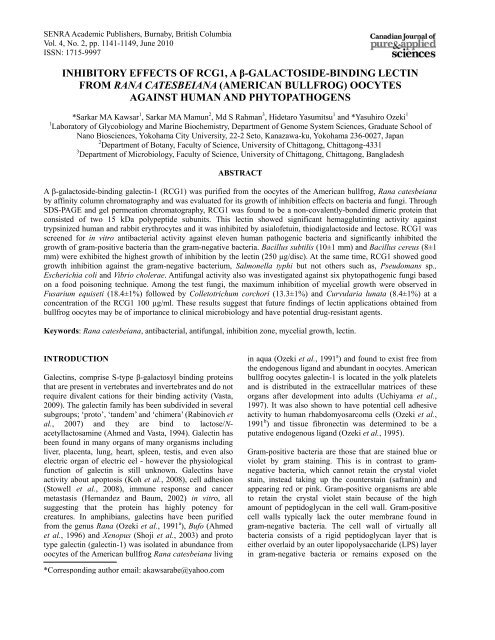Download (5Mb) - Covenant University Repository
Download (5Mb) - Covenant University Repository
Download (5Mb) - Covenant University Repository
You also want an ePaper? Increase the reach of your titles
YUMPU automatically turns print PDFs into web optimized ePapers that Google loves.
SENRA Academic Publishers, Burnaby, British Columbia<br />
Vol. 4, No. 2, pp. 1141-1149, June 2010<br />
ISSN: 1715-9997<br />
INHIBITORY EFFECTS OF RCG1, A β-GALACTOSIDE-BINDING LECTIN<br />
FROM RANA CATESBEIANA (AMERICAN BULLFROG) OOCYTES<br />
AGAINST HUMAN AND PHYTOPATHOGENS<br />
*Sarkar MA Kawsar 1 , Sarkar MA Mamun 2 , Md S Rahman 3 , Hidetaro Yasumitsu 1 and *Yasuhiro Ozeki 1<br />
1 Laboratory of Glycobiology and Marine Biochemistry, Department of Genome System Sciences, Graduate School of<br />
Nano Biosciences, Yokohama City <strong>University</strong>, 22-2 Seto, Kanazawa-ku, Yokohama 236-0027, Japan<br />
2 Department of Botany, Faculty of Science, <strong>University</strong> of Chittagong, Chittagong-4331<br />
3 Department of Microbiology, Faculty of Science, <strong>University</strong> of Chittagong, Chittagong, Bangladesh<br />
ABSTRACT<br />
A β-galactoside-binding galectin-1 (RCG1) was purified from the oocytes of the American bullfrog, Rana catesbeiana<br />
by affinity column chromatography and was evaluated for its growth of inhibition effects on bacteria and fungi. Through<br />
SDS-PAGE and gel permeation chromatography, RCG1 was found to be a non-covalently-bonded dimeric protein that<br />
consisted of two 15 kDa polypeptide subunits. This lectin showed significant hemagglutinting activity against<br />
trypsinized human and rabbit erythrocytes and it was inhibited by asialofetuin, thiodigalactoside and lectose. RCG1 was<br />
screened for in vitro antibacterial activity against eleven human pathogenic bacteria and significantly inhibited the<br />
growth of gram-positive bacteria than the gram-negative bacteria. Bacillus subtilis (10±1 mm) and Bacillus cereus (8±1<br />
mm) were exhibited the highest growth of inhibition by the lectin (250 µg/disc). At the same time, RCG1 showed good<br />
growth inhibition against the gram-negative bacterium, Salmonella typhi but not others such as, Pseudomans sp.,<br />
Escherichia coli and Vibrio cholerae. Antifungal activity also was investigated against six phytopathogenic fungi based<br />
on a food poisoning technique. Among the test fungi, the maximum inhibition of mycelial growth were observed in<br />
Fusarium equiseti (18.4±1%) followed by Colletotrichum corchori (13.3±1%) and Curvularia lunata (8.4±1%) at a<br />
concentration of the RCG1 100 µg/ml. These results suggest that future findings of lectin applications obtained from<br />
bullfrog oocytes may be of importance to clinical microbiology and have potential drug-resistant agents.<br />
Keywords: Rana catesbeiana, antibacterial, antifungal, inhibition zone, mycelial growth, lectin.<br />
INTRODUCTION<br />
Galectins, comprise S-type β-galactosyl binding proteins<br />
that are present in vertebrates and invertebrates and do not<br />
require divalent cations for their binding activity (Vasta,<br />
2009). The galectin family has been subdivided in several<br />
subgroups; ‘proto’, ‘tandem’ and ‘chimera’ (Rabinovich et<br />
al., 2007) and they are bind to lactose/Nacetyllactosamine<br />
(Ahmed and Vasta, 1994). Galectin has<br />
been found in many organs of many organisms including<br />
liver, placenta, lung, heart, spleen, testis, and even also<br />
electric organ of electric eel - however the physiological<br />
function of galectin is still unknown. Galectins have<br />
activity about apoptosis (Koh et al., 2008), cell adhesion<br />
(Stowell et al., 2008), immune response and cancer<br />
metastasis (Hernandez and Baum, 2002) in vitro, all<br />
suggesting that the protein has highly potency for<br />
creatures. In amphibians, galectins have been purified<br />
from the genus Rana (Ozeki et al., 1991 a ), Bufo (Ahmed<br />
et al., 1996) and Xenopus (Shoji et al., 2003) and proto<br />
type galectin (galectin-1) was isolated in abundance from<br />
oocytes of the American bullfrog Rana catesbeiana living<br />
*Corresponding author email: akawsarabe@yahoo.com<br />
in aqua (Ozeki et al., 1991 a ) and found to exist free from<br />
the endogenous ligand and abundant in oocytes. American<br />
bullfrog oocytes galectin-1 is located in the yolk platelets<br />
and is distributed in the extracellular matrices of these<br />
organs after development into adults (Uchiyama et al.,<br />
1997). It was also shown to have potential cell adhesive<br />
activity to human rhabdomyosarcoma cells (Ozeki et al.,<br />
1991 b ) and tissue fibronectin was determined to be a<br />
putative endogenous ligand (Ozeki et al., 1995).<br />
Gram-positive bacteria are those that are stained blue or<br />
violet by gram staining. This is in contrast to gramnegative<br />
bacteria, which cannot retain the crystal violet<br />
stain, instead taking up the counterstain (safranin) and<br />
appearing red or pink. Gram-positive organisms are able<br />
to retain the crystal violet stain because of the high<br />
amount of peptidoglycan in the cell wall. Gram-positive<br />
cell walls typically lack the outer membrane found in<br />
gram-negative bacteria. The cell wall of virtually all<br />
bacteria consists of a rigid peptidoglycan layer that is<br />
either overlaid by an outer lipopolysaccharide (LPS) layer<br />
in gram-negative bacteria or remains exposed on the

















